

Grammar


Tenses


Present

Present Simple

Present Continuous

Present Perfect

Present Perfect Continuous


Past

Past Simple

Past Continuous

Past Perfect

Past Perfect Continuous


Future

Future Simple

Future Continuous

Future Perfect

Future Perfect Continuous


Parts Of Speech


Nouns

Countable and uncountable nouns

Verbal nouns

Singular and Plural nouns

Proper nouns

Nouns gender

Nouns definition

Concrete nouns

Abstract nouns

Common nouns

Collective nouns

Definition Of Nouns

Animate and Inanimate nouns

Nouns


Verbs

Stative and dynamic verbs

Finite and nonfinite verbs

To be verbs

Transitive and intransitive verbs

Auxiliary verbs

Modal verbs

Regular and irregular verbs

Action verbs

Verbs


Adverbs

Relative adverbs

Interrogative adverbs

Adverbs of time

Adverbs of place

Adverbs of reason

Adverbs of quantity

Adverbs of manner

Adverbs of frequency

Adverbs of affirmation

Adverbs


Adjectives

Quantitative adjective

Proper adjective

Possessive adjective

Numeral adjective

Interrogative adjective

Distributive adjective

Descriptive adjective

Demonstrative adjective


Pronouns

Subject pronoun

Relative pronoun

Reflexive pronoun

Reciprocal pronoun

Possessive pronoun

Personal pronoun

Interrogative pronoun

Indefinite pronoun

Emphatic pronoun

Distributive pronoun

Demonstrative pronoun

Pronouns


Pre Position


Preposition by function

Time preposition

Reason preposition

Possession preposition

Place preposition

Phrases preposition

Origin preposition

Measure preposition

Direction preposition

Contrast preposition

Agent preposition


Preposition by construction

Simple preposition

Phrase preposition

Double preposition

Compound preposition

prepositions


Conjunctions

Subordinating conjunction

Correlative conjunction

Coordinating conjunction

Conjunctive adverbs

conjunctions


Interjections

Express calling interjection

Phrases

Sentences


Grammar Rules

Passive and Active

Preference

Requests and offers

wishes

Be used to

Some and any

Could have done

Describing people

Giving advices

Possession

Comparative and superlative

Giving Reason

Making Suggestions

Apologizing

Forming questions

Since and for

Directions

Obligation

Adverbials

invitation

Articles

Imaginary condition

Zero conditional

First conditional

Second conditional

Third conditional

Reported speech

Demonstratives

Determiners


Linguistics

Phonetics

Phonology

Linguistics fields

Syntax

Morphology

Semantics

pragmatics

History

Writing

Grammar

Phonetics and Phonology

Semiotics


Reading Comprehension

Elementary

Intermediate

Advanced


Teaching Methods

Teaching Strategies

Assessment
Finding the underlying form
المؤلف:
David Odden
المصدر:
Introducing Phonology
الجزء والصفحة:
85-4
26-3-2022
4399
Finding the underlying form
A similar problem arises in explaining the partitive and nominative forms of nouns in Finnish. The first step in understanding the phonological alternation seen here is to do a standard preliminary morphological analysis of the data, which involves identifying which parts of a word correlate with each aspect of word structure (such as root meaning or grammatical case). The following examples illustrate that the nominative singular suffix is Ø (i.e. there is no overt suffix in the nominative singular) and the partitive singular suffix is -æ, which alternates with -a if there is a back vowel somewhere before it in the word (we will not be concerned with that vowel alternation in the partitive suffix)
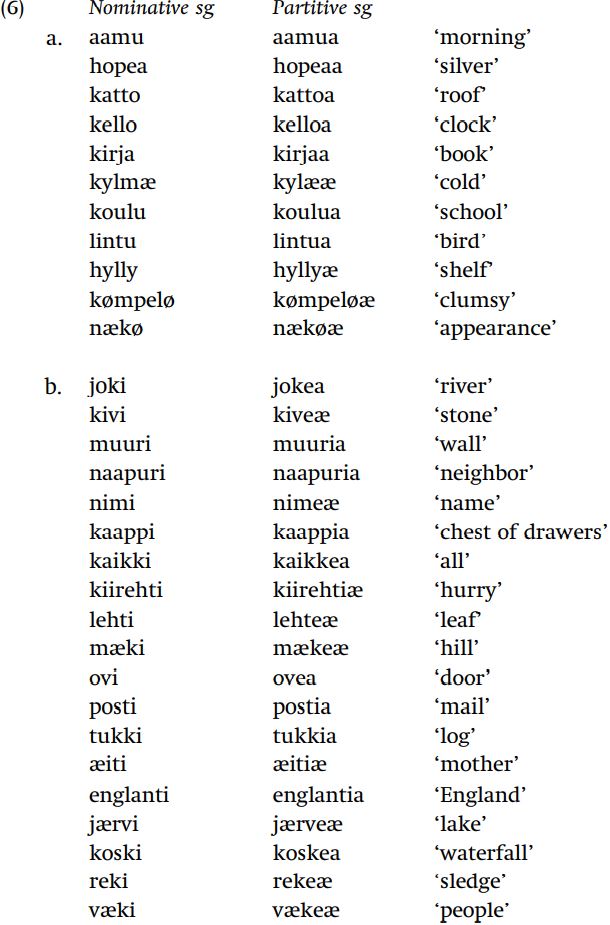
We might assume that the underlying form of the root is the same as the nominative (which has no suffix). The problem which these data pose is that in some nouns, the partitive appears to be simply the nominative plus the suffix -æ ~ -a (for example muuri ~ muuria), but for other nouns the final vowel alternates, with [i] in the nominative and [e] in the partitive (e.g. joki ~ jokea). It is obvious that the nature of the following vowel does not explain this alternation, since the same surface-quality suffix vowel can appear after either e or i – compare jokea, nimeæ where [e] appears before both [a] and [æ], versus muuria, kiirehtiæ where [i] appears before these same vowels. Nor can the preceding consonant be called upon to predict what vowel will appear in the partitive, as shown by pairs such as tukkia, kaikkea versus lehteæ, æitiæ.
This is an area where there is (potentially) a difference between language-learning pedagogy and a formal linguistic analysis. Faced with the problem of learning the inflectional distinction muuri ~ muuria versus joki ~ jokea, a second-language class on Finnish might simply have the student memorize a list of words like joki ~ jokea where the vowel changes in the inflectional paradigm. From the point of view of linguistic analysis this is the wrong way to look at the question, since it implies that this is not a rule-governed property of the language. However, second-language learning is not the same as linguistic analysis: a class in foreign-language instruction has a different goal from a class in analysis, and some students in a language class may receive greater practical benefit from just memorizing a list of words. Thus it is important to distinguish the teaching method where one learns arbitrary lists, and a theoretically based analysis. One simply cannot predict what vowel will appear in the partitive form if one only considers the pronunciation of the nominative. This means: nominative forms are not the same as underlying forms (some-thing that we also know given the previous Russian example). The underlying representation must in some way contain that information which determines whether there will be a vowel alternation in a given word.
In looking for the phonological basis for this vowel alternation, it is important to realize that the alternation in stem-final vowels is not chaotic, for we find precisely two possibilities, either i in the nominative paired with i in the partitive, or i in the nominative paired with e in the partitive – never, for example, i paired with u or i paired with o. Moreover, only the vowel i enters into such a vowel alternation in Finnish, so there are no nouns with o in the nominative which is replaced by u in the partitive, nor is u in the nominative ever replaced by o or any other vowel in the partitive. One final fact about the data in (6) suggests exactly how the right underlying representations can explain this alternation: of the eight vowels of Finnish [i, y, e, ø, æ, u, o, a], all of them appear at the end of the word except the vowel e. Now, since the stem of the word for ‘name,’ which appears as nimi in the nominative, actually appears on the surface as nime- in the partitive, it is not at all unreasonable to assume that the underlying form of the stem is in fact /nime/. It would be a bit bizarre to assume an underlying form such as /nima/, since the vowel [a] never appears in that position in any form of this word: the most natural assumption to make is that the underlying form of a morpheme is actually composed of segments found in some surface manifestation of the morpheme. On the other hand, the stem of the word for ‘wall’ is pronounced muuri in both the nominative and the partitive, and therefore there is no reason to assume that it is underlyingly anything other than /muuri/.
We will then assume that the underlying vowel at the end of the stem is actually reflected by the partitive form, and thus we would assume underlying representations such as /joke/, /nime/, /kive/, /lehte/, /ove/, and so on, as well as /muuri/, /naapuri/, /kaappi/, /tukki/, and so on. The underlying form of partitive [joke-a] would thus be /joke-a/, that is, no rule at all is required to explain the partitive. Instead, a rule is needed to explain the surface form of the nominative [joki], which derives from /joke/. A very simple neutralizing rule can explain the surface form of the nominative: underlying word-final e is raised to i.
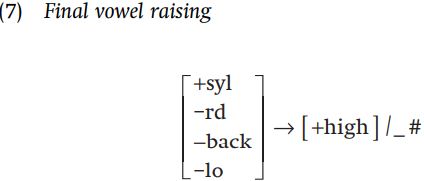
This rule is neutralizing since the distinction between /i/ and /e/ is neutralized by applying this rule: an underlying /e/ becomes phonetic [i].
Apart from illustrating how important correct underlying forms are, these two examples have also shown that it is dangerous, and incorrect in these two cases, to assume that the “most basic” form of a word according to morphological criteria is also the underlying form of the word. To reiterate: the underlying form of a morpheme is a hypothesis set forth by the analyst, a claim that by assuming such-and-such an underlying form, plus some simple set of rules (which need to be discovered by the analyst), the observed variation in the shape of morphemes can be explained.
Kerewe. To better understand the reasoning that leads to correct underlying forms, we investigate other examples. Consider the following data from Kerewe (Tanzania).
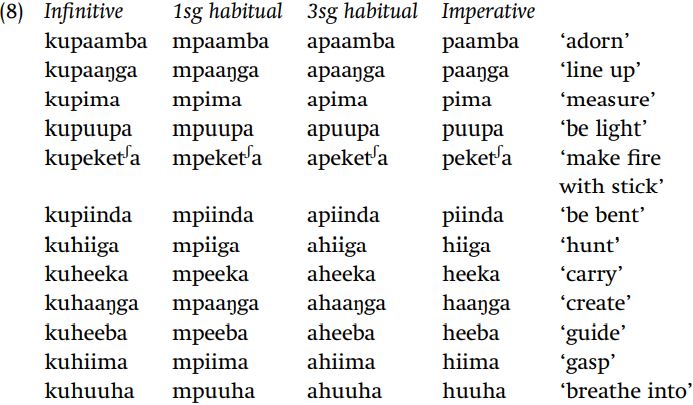
We notice that every infinitive begins with ku-, which we surmise is the prefix for the infinitive; the third-singular habitual form has the prefix a-, and the first-singular habitual has the prefix m-; the imperative involves no prefix. In addition to segmental prefixes, there is a change in the first consonant of the stem in some verbs, in some contexts. The initial consonant of the verb meaning ‘guide’ alternates between [h] and [p], with [p] appearing in the first-singular habitual after [m] and [h] appearing elsewhere. Since this stem appears in two surface variants, [heeba] and [peeba], two plausible hypotheses are immediately possible: the stem is underlyingly /peeba/, or the stem is underlyingly /heeba/. If we assume that the stem is underlyingly /heeba/, we require a rule to explain the divergence between the predicted form of the first-singular habitual form – we would expect *[mheeba], *[mhiima], etc. – and the actual form of the verb, [mpeeba], [mpiima], and so on. Since in fact we do not see the sequence /mh/ anywhere in the data, we might assume the following neutralizing rule.

If, on the other hand, we assume that the root is underlyingly /peeba/, we would need a rule which changes /p/ into [h] when not preceded by a nasal – in other words, when preceded by a vowel or by nothing. There is no single property which groups together word-initial position and vowels. Thus, the supposed rule changing /p/ to [h] would have to be a disjunction of two separate environments.

This suggests that rule (10) is wrong.
More important than the greater complexity of the rule entailed by assuming that the word for ‘guide’ is underlyingly /peeba/, it is empirically wrong: rule (10) implicitly claims that /p/ should always become [h] word-initially or after a vowel, but this is falsified by forms such as kupaamba, apaamba, paamba ‘adorn’ and kupaaŋga, apaaŋga, paaŋga ‘line up.’ If we assume the stems uniformly begin with /p/, then we cannot predict whether the imperative or infinitive has [h] (kuhaaŋga) or [p] (kupaaŋga). On the other hand, if we assume an underlying contrast between initial /h/ and initial /p/ – i.e. haaŋga ‘create,’ paaŋga ‘arrange’ – then we can correctly distinguish those stems which begin with /h/ from those which begin with /p/ when no nasal precedes, as well as correctly neutralizing that distinction just in case the stem is preceded by a nasal (mpaaŋga ‘I create’; ‘I arrange’).
The rule formalization in (9) exploits a widely used notion about how rules apply, known as structure preservation. Notice that the structural change specified mentions only that /h/ becomes [–cont, +ant], which are two features that characterize the difference between /h/ and [p]. There are two other actual changes in feature which are not explicitly mentioned, namely that the segment becomes [+cons, –son]. These values can be automatically predicted from the fact that in this language, there is only one voiceless [+ant, –cor] stop, namely [p]. The idea underlying structure preservation is that each language defines an inventory of segments, and the structural change of a rule changes from one sound within the inventory to another sound. Specifying that change as [-cont; + ant; + cons; - son] fully specifies what the result of the rule is, but [-cont; + ant] identifies the same unique segment of the language, more economically.
English plurals. A further illustration of how to determine the correct underlying representation comes from English. As the following examples illustrate, the surface form of the plural suffix varies between [s] and [z] (as well as [ɨz], to be discussed later).

The generalization regarding distribution is straightforward: [s] appears after a voiceless segment, and [z] appears after a voiced one (be it an obstruent, a liquid, nasal or a vowel).
This same alternation can be found in the suffix marking the third-singular present-tense form of verbs.

If we suppose that the underlying form of the affixes for noun plural and third-singular present verbs is /z/, then we would assume the following rule to derive the phonetic variant [s].

On the other hand, if we were to assume that these suffixes are underlyingly /s/, we would assume the following rule.

In terms of the simplicity and generality of these two rules, the analyses are comparable. Both formulations require the same number of phonetic specifications to state the rule, and both formulations apply to general and phonetically natural classes. However, the two analyses differ quite significantly in terms of their overall predictions for English. The implicit prediction of the first rule (13) is that there should be no voiced obstruents after voiceless segments in English, since that rule would devoice all such obstruents. This generalization seems to be correct: there are no words like *[jəkd], *[pɪfz], *[sdap]. The implicit prediction of the second rule (14) is different: that rule implies that there should be no voiceless segments after any voiced segments. This is manifestly incorrect, as shown by the existence of words such as [hɪs] hiss, [pæθ] path, [dæns] dance, [fals] false. We prefer a hypothesis which makes the correct prediction about the phonetic structure of the language as a whole, and thus we select the underlying form /z/ and a rule devoicing obstruents after voiceless segments. Looking for such asymmetries plays an important role in determining which of two hypotheses is the correct one.
The alternation z ~ s is not limited to the two affixes -z ‘plural’ and -z ‘3sg present tense.’ The rule of devoicing can also be seen applying to the possessive suffix -z.
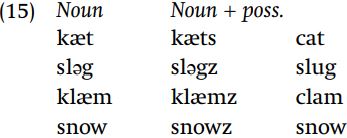
Moreover, certain auxiliary verbs such as has [hæz] and is [ɪs] undergo a reduction in casual speech, so that they appear simply as [s] or [z], the choice between these two being determined by the devoicing rule which we have motivated.

The devoicing rule (13) automatically explains the alternation in the surface shape of the consonant here as well.
Jita tone. It is important to look for correlations which may lead to causal explanations, in analyzing data. Consider the following data from Jita (Tanzania), concentrating on the tones of morphemes (H or high tone is marked with acute accent, L or low-toned syllables are unmarked).
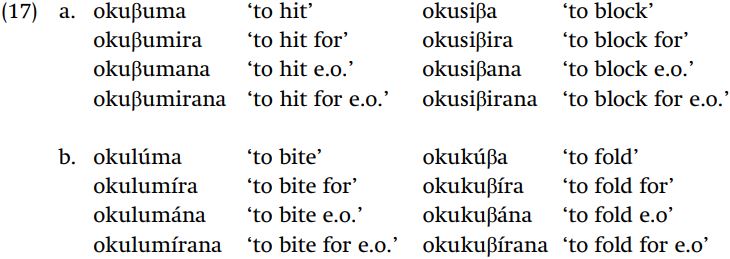
We can conclude that there is a prefix oku- perhaps marking the infinitive, a suffix -a appearing at the end of every verb, and two suffixes -ir- ‘for’ and -an- ‘each other.’ There are also root morphemes: -βum- ‘hit,’ -siβ- ‘block,’ as well as -lúm- ‘bite’ and -kúβ- ‘fold.’ We decide that ‘bite’ and ‘fold’ underlyingly have H tones in part based on the fact that there actually is an H tone on the vowels of these roots in the simplest verb forms.
In addition, we observe that the suffixes -ir- and -an- have H tone when they come immediately after these verb roots. The suffixes do not have H tone after the first set of roots: appearance of H on the suffix is correlated with which morpheme immediately precedes the suffix. Since this unpredictable property is correlated with the preceding root morpheme, it must therefore be an aspect of the underlying form of the preceding morpheme.
We thus explain the H tone on these suffix morphemes by positing that [oku-lum-án-a] derives from underlying /oku-lúm-an-a/, by applying a rule of tone shift which shifts an H tone rightward to the following syllable, as long as the syllable is not word-final. Because of the restriction that H does not shift to a final syllable, the underlying H surfaces unchanged in [okulúma].
Now consider the following data.

When the L-toned roots of (17a) stand after the object prefixes -mu- ‘him/ her’ and -t ʃ i- ‘it,’ they have an H tone at the beginning of the root. Again, since the presence of the H is correlated unpredictably with the prefixes -mu- and -t ʃ i-, we hypothesize that the tones are part of the underlying representation of the prefixes – the prefixes are /mú/ and /t ʃ í/, and the H tone shifts to the right by the tone shift rule which we have already posited.
 الاكثر قراءة في Phonology
الاكثر قراءة في Phonology
 اخر الاخبار
اخر الاخبار
اخبار العتبة العباسية المقدسة

الآخبار الصحية















 قسم الشؤون الفكرية يصدر كتاباً يوثق تاريخ السدانة في العتبة العباسية المقدسة
قسم الشؤون الفكرية يصدر كتاباً يوثق تاريخ السدانة في العتبة العباسية المقدسة "المهمة".. إصدار قصصي يوثّق القصص الفائزة في مسابقة فتوى الدفاع المقدسة للقصة القصيرة
"المهمة".. إصدار قصصي يوثّق القصص الفائزة في مسابقة فتوى الدفاع المقدسة للقصة القصيرة (نوافذ).. إصدار أدبي يوثق القصص الفائزة في مسابقة الإمام العسكري (عليه السلام)
(نوافذ).. إصدار أدبي يوثق القصص الفائزة في مسابقة الإمام العسكري (عليه السلام)


















